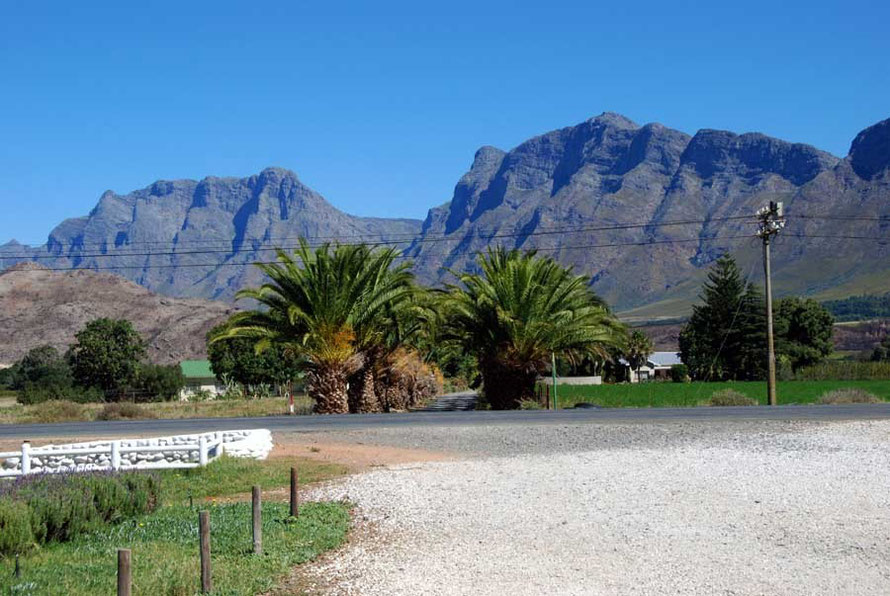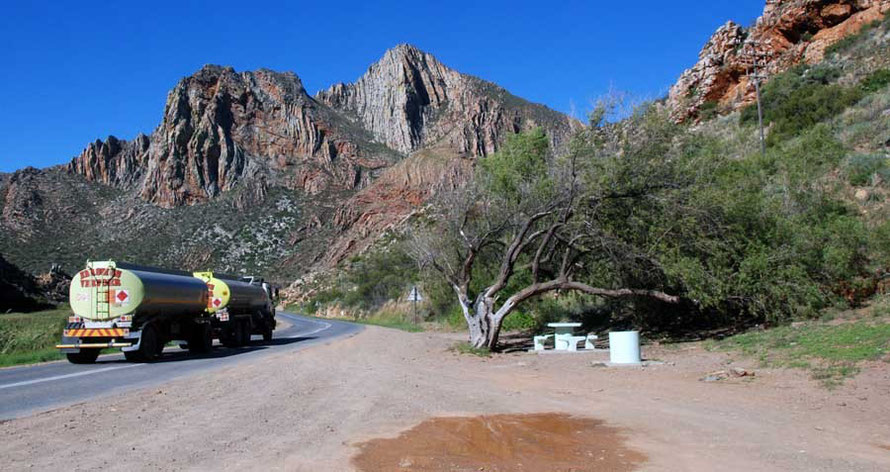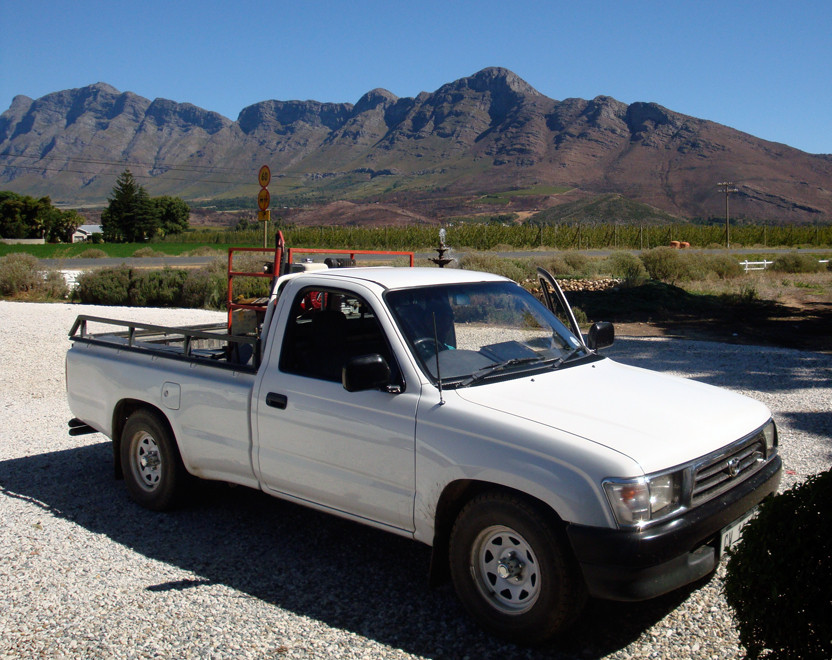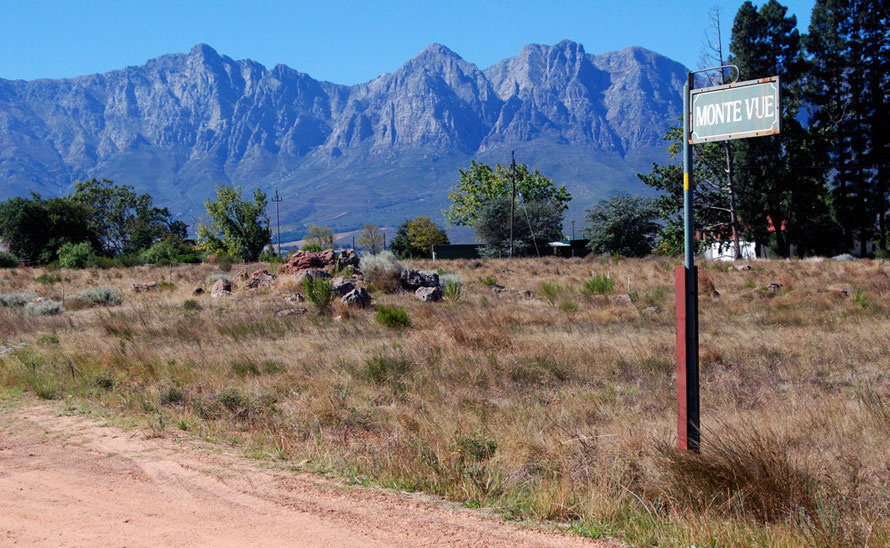Wineland III: The Breede River Valley

Once on the valley floor we stopped at the first farm stand, as they are called, that we came to. It stood in a bleak location, huddled beneath a bunch of scrawny eucalyptus trees, a big dusty apron around. Coloured farm workers took advantage of the shade in their tatty overalls and wellington boots - yes - in that heat.
We trooped self-consciously into the shop each saying 'Hi' as we entered. The women at the till in some amusement say 'Hi' back to each of us as if to say, 'So many hi's already'.
The shop is charming the woman in charge is charming too, asking me why I have not come to live in South Africa. I am somewhat nonplussed but nevertheless delighted not to be mistaken for a thick-necked boer - literally 'farmer'. Which is a typical Anglo-Saxon response in a country where the English have been looking down their acqualine noses at the 'crude and uncultured' Afrikaners for two centuries at least.
We buy chicken patties and I can't resist a huge bag of dried peaches for only R50 (£3.58). I also get fresh figs and Peg and Amy buy delicious poppy seed rusks and crisps and drinks. The shop-woman gives me a freebie of an extra bag of mixed dry fruits. Smashing.
A white guy - big in his shorts and boots, with the thick neck - turns up when we are in the shop, his dusty bakkie outside. There is no greeting and he sniffs around the place looking at stuff as if it might be contaminated, hardly worth his attention, hardly meriting the stop. You see scenes of the old way played out in bakkies - the black and coloured labourers in the back, the white baas, driving alone in the cab. Indeed, there are times in the Breede River Valley when you wonder if Apartheid ever finished.
Back in the car we debate the phytosanitary conditions under which the chicken patties were kept. They were frozen but in non-refrigerated displays. They were then heated in a microwave. Will be safe or will we be chucking-up from here to Montagu? The woman had told us that the patties had been made by the 'farm women hereabouts' and my romantic inclination was to believe in good hygeine and good chickens. Three were eaten and one discarded all to no ill-effect. The warming in the microwave destroyed the delicacy of the pastry and the anxiety seemed to kill the tastebuds as we rolled out into the heavy lorry traffic on the M43.

Intensive fruit and wine production in the Breede River Valley above Worcester

We proceed to mix it with lots of trucks going like stink along the valley floor moving giant boxes of grapes through interminable single file roadworks. We crossed the N1 at a tricky congested junction, too the ring road around Worcester, the centre of the Breede valley, and down a long two-lane road with yellow lined passing lanes to Robertson and Ashton. This particular configuration of tarmac and yellow line was a novelty for the driver who took some time to get the hang of pulling over at speed into the hard shoulder, inches from the edge of the road and a ditch, to let barrelling lorries roar past. All passengers took a lively interest in the driver's learning curve and gradually bolder decisions to overtake said barelling lorries on long inclines.
The road varied from the immaculate vineyards - made possible with drip irrigation systems from the waters of the Breede River - and then up into dry barren looking scrubland with no settlements but for a few abandoned huts before heading down into the towns of Robertson and Ashton with their big wine and fruit factories, their own townships of Zolani – situated on scrubland 3-4km from Ashton – and Nkqubela.
Much of the grape crop here was used to make grape concentrate and juice back in the day. The rest went for brandy and fortified wines. Robertson now has its own label wine which has achieved a reputation for its Shiraz and there are older estates down by the river that apparently make decent reds. But the reds are big, heavy and thick with, for me and our limited price range, a muddy mixed-up taste - Jancis Robinson says the reds, which often don't ripen fully due to virus problems taste 'strangely earthy to foreigners'. They are called dikvoet in Afrikaans - 'thick foot.'

Here the climate is more extreme than the Franschhoek, Stellanbosch and Constantia wines. The cooling south-easterlies blowing of the cold Antartic Benguela current are blocked by the mountains and summer temperatures sore. In other areas the South-Easterly, which will whip the tops off young vines, is known as the Cape Doctor because it wards off rot and mildew.
We turn off at Zolani township for the road to Montagu that takes us through the Langeberg mountains with their quite spectacular folding, as if they were Brighton rock on the puller's table. Montagu is at the back of the mountains and signals the beginning of the much drier Little Karoo semi-desert region and then up into the Karoo proper and up and the vast platteland ('flat land') of South Africa's interior.




